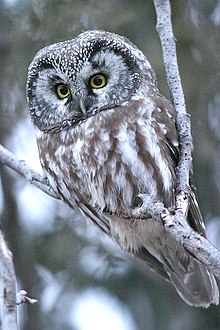
The snowy owl, also known as the polar owl, the white owl and the Arctic owl, is a large, white owl of the true owl family. Snowy owls are native to the Arctic regions of both North America and the Palearctic, breeding mostly on the tundra. It has a number of unique adaptations to its habitat and lifestyle, which are quite distinct from other extant owls. One of the largest species of owl, it is the only owl with mainly white plumage. Males tend to be a purer white overall while females tend to have more extensive flecks of dark brown. Juvenile male snowy owls have dark markings that may appear similar to females until maturity, at which point they typically turn whiter. The composition of brown markings about the wing, although not foolproof, is the most reliable technique to age and sex individual snowy owls.

The common goldeneye or simply goldeneye is a medium-sized sea duck of the genus Bucephala, the goldeneyes. Its closest relative is the similar Barrow's goldeneye. The genus name is derived from the Ancient Greek boukephalos, a reference to the bulbous head shape of the bufflehead. The species name is derived from the Latin clangere.
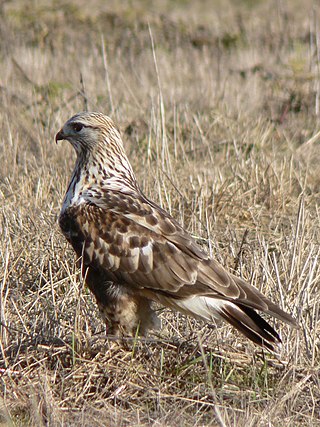
The rough-legged buzzard (Europe) or rough-legged hawk is a medium-large bird of prey. It is found in Arctic and Subarctic regions of North America, Europe, and Russia during the breeding season and migrates south for the winter. It was traditionally also known as the rough-legged falcon in such works as John James Audubon's The Birds of America.
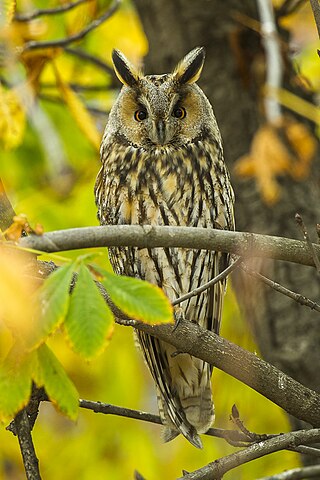
The long-eared owl, also known as the northern long-eared owl or, more informally, as the lesser horned owl or cat owl, is a medium-sized species of owl with an extensive breeding range. The scientific name is from Latin. The genus name Asio is a type of eared owl, and otus also refers to a small, eared owl. The species breeds in many areas through Europe and the Palearctic, as well as in North America. This species is a part of the larger grouping of owls known as typical owls, of the family Strigidae, which contains most extant species of owl.
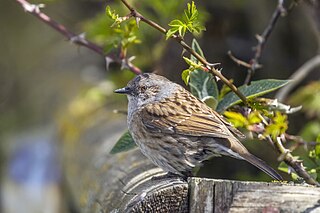
The dunnock is a small passerine, or perching bird, found throughout temperate Europe and into Asian Russia. Dunnocks have also been introduced into New Zealand. It is by far the most widespread member of the accentor family; most other accentors are limited to mountain habitats. Other common names of the dunnock include: hedge accentor, hedge sparrow, hedge warbler, and titling.
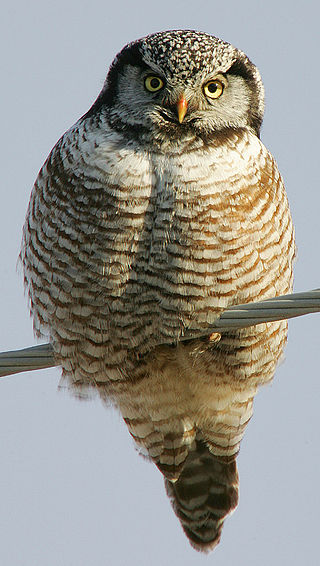
The northern hawk-owl or northern hawk owl is a medium-sized true owl of the northern latitudes. It is non-migratory and usually stays within its breeding range, though it sometimes irrupts southward. It is one of the few owls that is neither nocturnal nor crepuscular, being active only during the day. This is the only living species in the genus Surnia of the family Strigidae, the "typical" owls. The species is sometimes called simply the hawk owl; however, many species of owls in the genus Ninox are also called "hawk owls".

The Eurasian pygmy owl is the smallest owl in Europe. It is a dark reddish to greyish-brown, with spotted sides and half of a white ring around the back of the neck. This species is found in the boreal forests of Northern and Central Europe to Siberia.

The northern saw-whet owl is a species of small owl in the family Strigidae. The species is native to North America. Saw-whet owls of the genus Aegolius are some of the smallest owl species in North America. They can be found in dense thickets, often at eye level, although they can also be found some 20 ft (6.1 m) up. Saw-whets are often in danger of being preyed upon by larger birds of prey. The northern saw-whet owl is a migratory bird without any strict pattern.

The Canada jay, also known as the gray jay, grey jay, camp robber, or whisky jack, is a passerine bird of the family Corvidae. It is found in boreal forests of North America north to the tree line, and in the Rocky Mountains subalpine zone south to New Mexico and Arizona. A fairly large songbird, the Canada jay has pale grey underparts, darker grey upperparts, and a grey-white head with a darker grey nape. It is one of three members of the genus Perisoreus, a genus more closely related to the magpie genus Cyanopica than to other birds known as jays. The Canada jay itself has nine recognized subspecies.

The boreal owl or Tengmalm's owl is a small owl in the "true owl" family Strigidae. It is known as the boreal owl in North America and as Tengmalm's owl in Europe after Swedish naturalist Peter Gustaf Tengmalm or, more rarely, Richardson's owl after Sir John Richardson.

The blue-headed vireo is a Neotropical migrating song bird found in North and Central America. There are currently two recognized subspecies that belong to the blue-headed vireo. It has a range that extends across Canada and the eastern coast of the United-States, Mexico and some of Central America. It prefers large temperate forests with a mix of evergreen trees and deciduous under growth.

The spotted owlet is a small owl which breeds in tropical Asia from mainland India to Southeast Asia. A common resident of open habitats including farmland and human habitation, it has adapted to living in cities. They roost in small groups in the hollows of trees or in cavities in rocks and buildings. It nests in a hole in a tree or building, laying 3–5 eggs. The species shows great variation including clinal variation in size and forms a superspecies with the very similar little owl.

The Ural owl is a large nocturnal owl. It is a member of the true owl family, Strigidae. The Ural owl is a member of the genus Strix, that is also the origin of the family's name under Linnaean taxonomy. Both its common name and scientific name refer to the Ural Mountains of Russia where the type specimen was collected. However, this species has an extremely broad distribution that extends as far west as much of Scandinavia, montane eastern Europe, and, sporadically, central Europe, thence sweeping across the Palearctic broadly through Russia to as far east as Sakhalin and throughout Japan. The Ural owl may include up to 15 subspecies, but most likely the number may be slightly fewer if accounting for clinal variations.

The elf owl is a small grayish-brown owl about the size of a sparrow found in the Southwestern United States, central Mexico, and the Baja California peninsula. It has pale yellow eyes highlighted by thin white "eyebrows" and a gray bill with a horn-colored tip. The elf owl frequently inhabit woodpecker holes in saguaro cacti; it also nests in natural tree cavities. It is nocturnal and feeds primarily on insects.

The buff-fronted owl is a small owl. It is found in widely separated areas in every South American country except French Guiana and Suriname.

The unspotted saw-whet owl is a small "typical owl" in subfamily Surniinae. It is found in Costa Rica, El Salvador, Guatemala, Mexico, and Panama.

The northern pygmy owl is a small owl native to western North America.

The Kentish plover is a small wader of the family Charadriidae that breeds on the shores of saline lakes, lagoons, and coasts, populating sand dunes, marshes, semi-arid desert, and tundra. Both male and female birds have pale plumages with a white underside, grey/brown back, dark legs and a dark bill; however, additionally the male birds also exhibit very dark incomplete breast bands, and dark markings either side of their head, therefore the Kentish plover is regarded as sexually dimorphic.
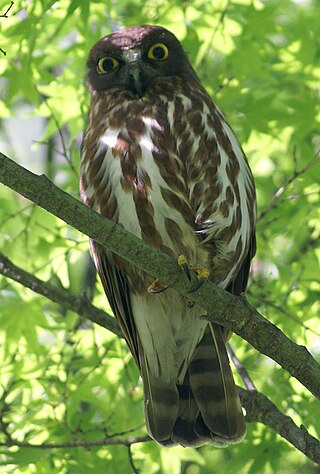
The northern boobook belongs to the family Strigidae and is a raptorial owl endemic to eastern and southern countries of Asia. The species was considered, until recently, a conspecific of Ninox scutulata or brown boobook, a species of similar distribution encompassing 11 subspecies. The species currently includes two subspecies, the migrant Ninox japonica japonica and the non-migrant Ninox japonica totogo. Despite being considered as the most common breeding owl in Japan, little research has been conducted on the species and subspecies and the taxonomic classification of N. j. totogo and N. j. japonica has been a subject of debate. There are no indications of significant decline in northern boobook populations and therefore its conservation status has been classified as least concern by the IUCN Red List.
